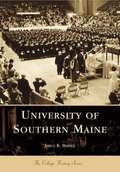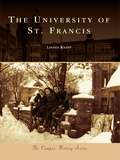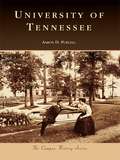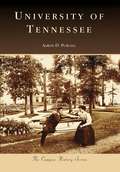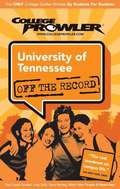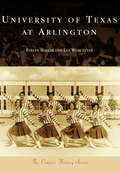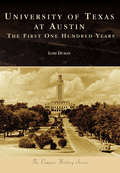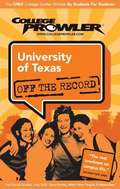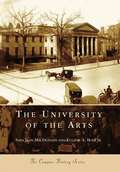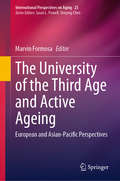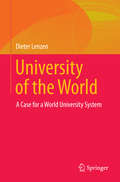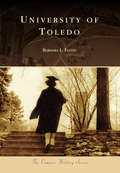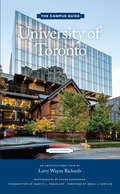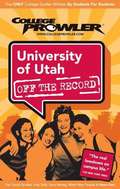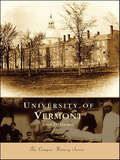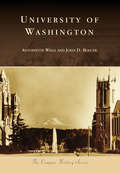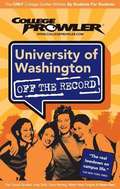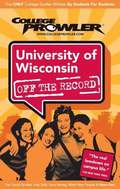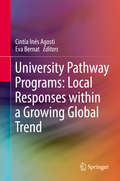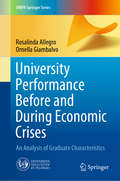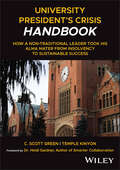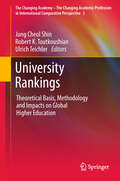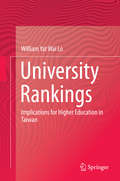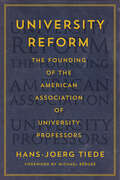- Table View
- List View
University Of Southern Maine
by Joyce K. BibberAlthough the University of Southern Maine has existed under that name for less than a quarter century, its roots lie much deeper in a normal school begun at Gorham in 1878; a junior college opened in Portland in 1933; and a business school, which lasted only from 1921 to 1925, but whose charter was revived two decades later to become Maine's only law school. Each of these roots underwent changes, and the alumni magazine now includes nine different seals across its news pages. The mergers of the founding institutions, plus the later development of new programs and the addition of new colleges, have made it a true university with the largest student enrollment of any educational institution in the state.
University of St. Francis (Campus History)
by Linnea KnappThe story of the University of St. Francis began in 1920 when the seeds were planted for Assisi Junior College. The school's evolution continued when, as the College of St. Francis, it awarded bachelor's degrees in 1930, became coeducational in 1970, and attained university status in 1998. The university owes its existence to the Congregation of the Sisters of St. Francis of Mary Immaculate, founded by Mother Alfred Moes in 1865, with Mother Thomasine Fryewska serving as the first president of the institution. Currently this vibrant community claims over 3,500 students on the main campus in Joliet, the many off-campus sites, and online. Throughout the years, the school has grown, adding buildings, programs, and students, but has remained rooted in its Franciscan identity of respect, service, integrity, and compassion.
University of Tennessee (Campus History)
by Aaron D. PurcellIn 1794, two years before Tennessee became a state, the legislature of the Southwest Territory chartered Blount College in Knoxville as one of the first three colleges established west of the Appalachian Mountains. In 1807, the school changed its name to East Tennessee College. The school relocated to a 40-acre tract, known today as "the Hill," in 1828 and was renamed East Tennessee University in 1840. The Civil War literally shut down the university. Students and faculty were recruited to serve on battlefields, and troops used campus facilities as hospitals and barracks. In 1869, East Tennessee University became the state's land-grant institution under the auspices of the 1862 Morrill Act. In 1879, the state legislature changed the name of the institution to the University of Tennessee. By the early 20th century, the university admitted women, hosted teacher institutes, and constructed new buildings. Since that time, the University of Tennessee has established campuses and programs across the state. Today, in addition to a rich sports tradition, the University of Tennessee provides Tennesseans with unparalleled opportunities.
University of Tennessee (The Campus History Series)
by Aaron D. PurcellIn 1794, two years before Tennessee became a state, the legislature of the Southwest Territory chartered Blount College in Knoxville as one of the first three colleges established west of the Appalachian Mountains. In 1807, the school changed its name to East Tennessee College. The school relocated to a 40-acre tract, known today as "the Hill," in 1828 and was renamed East Tennessee University in 1840. The Civil War literally shut down the university. Students and faculty were recruited to serve on battlefields, and troops used campus facilities as hospitals and barracks. In 1869, East Tennessee University became the state's land-grant institution under the auspices of the 1862 Morrill Act. In 1879, the state legislature changed the name of the institution to the University of Tennessee. By the early 20th century, the university admitted women, hosted teacher institutes, and constructed new buildings. Since that time, the University of Tennessee has established campuses and programs across the state. Today, in addition to a rich sports tradition, the University of Tennessee provides Tennesseans with unparalleled opportunities.
University of Tennessee (College Prowler)
by Jacob W. WilliamsNo university affiliations. No half-truths. No out-of-touch authors who haven't been in school for decades. A class project turned company, College Prowler produces guidebooks that are written by actual college students and cover the things students really want to know. Unlike other guides that jam everything into a five-pound book and devote only two pages to each college, our single-school guidebooks give students only the schools they want and all the information they need. From academics and diversity to nightlife and sports, we let the students tell it how it is. In addition to editorial reviews and grades for 20 different topics, more than 80 percent of each guide is composed of actual student reviews of their school. Whether readers are looking for "Best and Worst" lists, "Did You Knows?" or traditions, College Prowler guides have it all. Our books are the only place for local slang, urban legends, and tips on the best places to find a date, study, or grab a bite to eat.
University of Texas at Arlington (Campus History)
by Lea Worcester Evelyn BarkerIn 1895, seventy-five students enrolled at Arlington College, an elementary and secondary institution located on the North Texas prairies. Over the next 120 years, the school changed into a military school, a vocational college, a two-year college in the Texas A&M System, and finally, a full-fledged university with more than 34,000 students from across the globe. Throughout its history, UT Arlington has benefitted from strong leadership and strong community commitment to education. During the low-enrollment period of the Great Depression, Dean E.E. Davis went into the cornfields of East Texas to recruit students. In World War II, art professor Howard Joyner switched from teaching fine art to teaching the art of camouflage painting. The turbulent 1960s saw students clashing over the school's rebel flag theme, the resolution of which paved the way for the university to become one of the most diverse in the nation today.
University of Texas at Austin: The First One Hundred Years (Campus History)
by Lori DuranThe University of Texas (UT) opened in 1883--38 years after Texas became a state and 7 years after the Texas Constitution called for the creation of a university of the first class. UT started off with 40 acres just north of Austin and with 221 primarily rural and local students. But since its founding, it has grown extensively and acquired worldwide prominence. Now, UT has 431 acres on its main campus and over 51,000 students enrolled from all 50 states and, at least, 124 different nations. UT is recognized as a top-rated state university, providing high-quality instruction and research. The university has also acquired architecturally interesting buildings, cherished traditions, and exciting sports programs over the years.
University of Texas at Austin (College Prowler)
by Erin HallCollege guides for each of the top colleges and universities in the US. While writing our series of college guides, we felt it was critical that our content was unbiased and unaffiliated with any college or university. We think it's important that our readers get honest information and a realistic impression of the student opinions on any college campus that's why if any aspect of a particular college is terrible, we (unlike a campus brochure) intend to publish it. While we do keep an eye out for the occasional extremist the cheerleader or the cynic we take pride in letting the college students tell it like it is. We strive to create a college guide that's as representative as possible of each particular campus. Our guides cover both the good and the bad, and whether the survey responses point to recurring trends or a variation in opinion, these sentiments are directly and proportionally expressed through our guides.
The University of the Arts (The Campus History Series)
by Sara Jean Macdonald Eugene A. Bolt Jr.The University of the Arts is the nation's first and only university dedicated exclusively to education and training in the visual, design, performing, and media arts. Its history reflects Philadelphia's rich heritage of artistic innovation and accomplishment as well as its important historical position in American industry and manufacturing. Since the 1870s, the university has been a dynamic force in Philadelphia's vibrant artistic communities. The University of the Arts presents for the first time historic images gathered from the university's archives and numerous cultural institutions. Featured scenes include the Pennsylvania Museum and School of Industrial Art, the Philadelphia Musical Academy, the Philadelphia Conservatory of Music, the Philadelphia Dance Academy, and the architecture of John Haviland, Frank Furness, and Horace Trumbauer.
The University of the Third Age and Active Ageing: European and Asian-Pacific Perspectives (International Perspectives on Aging #23)
by Marvin FormosaThis comparative resource charts the interface between the University of the Third Age (U3A) movement and active ageing, and in doing so, offers a comprehensive and thorough understanding of what U3A means in different geographical and sociocultural contexts. After first providing introductory chapters to introduce the U3A movement and active ageing in global perspective and tracing the origins of U3As in France, the book sets off charting the international development of U3As in both European and Asian-Pacific contexts. Deliberately, the book moves away from the dominant Anglo-centric US- and UK-rooted analyses of U3As to account for contexts of different political ideology, sociocultural values, geography, and degrees of urbanisation and industrialisation. Lastly, it thematises foreseeable issues, concerns, and predicaments that the global U3A movement faces while meeting the challenges and seizing the opportunities presented by active ageing.The chapters’ comparative perspectives encompass: Origins and development: The Francophone model of U3As The development and characteristics of U3As in European and Asian-Pacific geographies From social welfare to educational gerontology: U3As in China, Russia, Taiwan, Malaysia and South Korea U3As in Italy, Spain and Sweden: A dynamic, flexible, and accessible learning model Late-life learning for social inclusion: U3As in Poland, Iceland, United Kingdom, and Malta The U3A movement in Australia: From statewide networking to community engagement Cross-cultural perspectives on U3As: The case of Thailand The University of the Third Age and Active Ageing boasts welcome contributions to the scholarship on the different histories, structures, and challenges posed by national U3As. Readers from a variety of backgrounds and research interests including gerontology, geriatrics, active ageing, older adult learning, comparative education and educational technology will find this a necessary and valuable resource in better understanding a globalised U3A world."The University of the Third Age and Active Ageing: European and Asian-Pacific Perspectives contributes to the deep well of histories, experiences, structures, accomplishments and problems of national U3As. It emerges as a tapestry of extraordinary research that offers to guide the U3A movement as it soon enters its fiftieth year of existence." - Prof. Stephen Katz. Trent University
University of the World
by Dieter LenzenIn this book, Dieter Lenzen analyzes the world's three major educational systems: the Continental-European, the Atlantic (Anglo-American) and the East Asian. Distancing himself from the current trend towards the economically driven Anglo-American system of education, the author proposes an alternative model, "a university of the world". Contents: · Three concepts of the university in the globalization process · The dynamics of global social systems · Global challenges in the post-secondary educational sector as springboard for comparing systems · Convergence and divergence: current system dynamics in the post-secondary sector · Can there be fair chances in a world university system? · Conclusion Target readers: · Theorists of higher education · Policy makers of higher education · Administrators of higher education · Social scientists The author: Professor Dr. Dieter Lenzen is the president of Universität Hamburg, vice president of the German Rectors' Conference (HRK) in Germany and the German universities' spokesperson for the HRK.
University of Toledo (Campus History)
by Barbara L. FloydIn 1872, Jesup W. Scott donated 160 acres of land to serve as an endowment for the Toledo University of Arts and Trades. Unfortunately, the university failed in its early years but was resurrected in 1884 by Scott's three sons, who gave the remaining assets to the City of Toledo to create a manual training school. By 1909, the institution was becoming a full-fledged university but struggled financially and did not have a permanent home. That changed in 1931 with the construction of the Bancroft Street campus, including the iconic University Hall, built in the Collegiate Gothic style. The University of Toledo remained a municipally supported university until 1967, when it joined Ohio's higher education system. In 2006, the University of Toledo merged with the former Medical College of Ohio, a state-supported institution founded in 1964. Today, the University of Toledo serves 20,000 students in degree programs as varied as medicine, law, engineering, business, education, pharmacy, nursing, and liberal arts.
The University of Toronto
by Martin L. FriedlandThe University of Toronto is Canada's leading university and one of Canada's most important cultural and scientific institutions. In this history of the University from its origin as King's College in 1827 to the present, Martin Friedland brings personalities, events, and changing visions and ideas into a remarkable synthesis. His scholarly yet highly readable account presents colourful presidents, professors, and students, notable intellectual figures from Daniel Wilson to Northrop Frye and Marshall McLuhan, and dramatic turning points such as the admission of women in the 1880s, the University College fire of 1890, the discovery of insulin, involvement in the two world wars, the student protests of the 1960s, and the successful renewal of the 1980s and 1990s.Friedland draws on archival records, private diaries, oral interviews, and a vast body of secondary literature. He draws also on his own experience of the University as a student in the 1950s and, later, as a faculty member and dean of law who played a part in some of the critical developments he unfolds.The history of the University of Toronto as recounted by Friedland is intimately connected with events outside the University. The transition in Canadian society, for example, from early dependence on Great Britain and fear of the United States to the present dominance of American culture and ideas is mirrored in the University. There too can be seen the effects of the two world wars, the cold war, and the Vietnam war. As Canadian society and culture have developed and changed, so too has the University. The history of the University in a sense is the history of Canada.
University of Toronto: Campus Guide (The Campus Guide)
by Larry Wayne RichardsUniversity of Toronto: The Campus Guide, second edition, portrays the dramatic growth and development of Canada's largest university while it showcases some of the finest architecture and landscapes in eleven curated walking tours. Founded in 1850 and built in a pastoral setting outside the city limits, the renowned university now has more than 90,000 students at three distinguished campuses: the downtown Toronto St. George campus, the University of Toronto Mississauga, and the University of Toronto Scarborough. Extraordinary new photographs and beautifully illustrated maps bring to life the university's historical evolution, from the nineteenth century to the present. University of Toronto is the newest addition in the acclaimed Campus Guide series of leading colleges and universities in North America.
University of Utah (College Prowler)
by Jared WhitleyNo university affiliations. No half-truths. No out-of-touch authors who haven't been in school for decades. A class project turned company, College Prowler produces guidebooks that are written by actual college students and cover the things students really want to know. Unlike other guides that jam everything into a five-pound book and devote only two pages to each college, our single-school guidebooks give students only the schools they want and all the information they need. From academics and diversity to nightlife and sports, we let the students tell it how it is. In addition to editorial reviews and grades for 20 different topics, more than 80 percent of each guide is composed of actual student reviews of their school. Whether readers are looking for "Best and Worst" lists, "Did You Knows?" or traditions, College Prowler guides have it all. Our books are the only place for local slang, urban legends, and tips on the best places to find a date, study, or grab a bite to eat.
University of Vermont (Campus History)
by John D. ThomasSince 1800, the University of Vermont has pursued a progressive mission of enlightening individuals and, through them, society.When university president Daniel Sanders welcomed the first class of students into the school, he envisioned the college as a "temple of knowledge." Balanced against the demands of national development, cultural change, and increased emphasis on academic specialization, UVM has seen generations of students who are intellectually curious and utilize their education into the practical needs of society. University of Vermont tells the story of the students, curriculum, and campus through a unique collection of drawings, paintings, and photographs, many of which are published here for the first time.
University of Washington
by John D. Bolcer Antoinette WillsThe University of Washington was founded in 1861, when Seattle was a tiny village. It struggled to survive during its early years, but after Washington achieved statehood in 1889, the university grew along with the region it served. A world's fair on its campus attracted international attention in 1909. A century later, the University of Washington is known worldwide for research and teaching in fields ranging from arts and sciences to health sciences and high technology. With three campuses (Seattle, Tacoma, and Bothell), extensive programs of professional and continuing education, and hundreds of thousands of alumni, the University of Washington has grown beyond anything its pioneer founders could have imagined.
University of Washington (College Prowler)
by Katie ShawNo university affiliations. No half-truths. No out-of-touch authors who haven't been in school for decades. A class project turned company, College Prowler produces guidebooks that are written by actual college students and cover the things students really want to know. Unlike other guides that jam everything into a five-pound book and devote only two pages to each college, our single-school guidebooks give students only the schools they want and all the information they need. From academics and diversity to nightlife and sports, we let the students tell it how it is. In addition to editorial reviews and grades for 20 different topics, more than 80 percent of each guide is composed of actual student reviews of their school. Whether readers are looking for "Best and Worst" lists, "Did You Knows?" or traditions, College Prowler guides have it all. Our books are the only place for local slang, urban legends, and tips on the best places to find a date, study, or grab a bite to eat.
University of Wisconsin (College Prowler)
by Nicole RosarioNo university affiliations. No half-truths. No out-of-touch authors who haven't been in school for decades. A class project turned company, College Prowler produces guidebooks that are written by actual college students and cover the things students really want to know. Unlike other guides that jam everything into a five-pound book and devote only two pages to each college, our single-school guidebooks give students only the schools they want and all the information they need. From academics and diversity to nightlife and sports, we let the students tell it how it is. In addition to editorial reviews and grades for 20 different topics, more than 80 percent of each guide is composed of actual student reviews of their school. Whether readers are looking for "Best and Worst" lists, "Did You Knows?" or traditions, College Prowler guides have it all. Our books are the only place for local slang, urban legends, and tips on the best places to find a date, study, or grab a bite to eat.
University Pathway Programs: Local Responses Within A Growing Global Trend
by Cintia Inés Agosti Eva BernatThis volume is the first to compile the insights of experienced and informed education researchers and practitioners involved in the delivery of university pathway programs. These programs have emerged as effective responses to global, national and local students’ needs when transitioning to Higher Education. The book opens with an overview of the main drivers for the development of university pathway programs, and a description of the main characteristics of such programs, as well as of the different types of programs available. It examines topics such as the way in which policy and governance issues at the institutional, state, and federal level affect university pathway programs’ financial models, compliance and quality assurance mechanisms as well as program provision. It also looks at how to address issues related to 'non-traditional' background students such as those from lower socioeconomic background, students for whom English is an additional language (EAL), indigenous students, mature age students and humanitarian entrants. The volume showcases thirteen university pathway programs offered in Australia, Canada, New Zealand, South Africa, Qatar, and the United Kingdom. These examples provide valuable insights that will help guide future practice in the field as the programs described effectively foster and support the development of students’ academic literacies, study skills and awareness of the socio-cultural norms that are necessary to participate successfully in higher education settings. In reporting the strategies to overcome challenges in the areas of curriculum development and implementation, of equity, inclusion and participation, of cross-sector collaboration and of student welfare, the volume promotes reflection on these issues and, therefore, better equips those education practitioners embarking on the university pathway program journey.
University Performance Before and During Economic Crises: An Analysis of Graduate Characteristics (UNIPA Springer Series)
by Rosalinda Allegro Ornella GiambalvoThis book briefly analyzes the performance of selected Italian universities during a pre-crisis period and an economic crisis period, on the basis of graduate characteristics and graduate placement statistics. The Electre model is used to produce eighteen university rankings according to three different scenarios (Neutral, University, and Job), three different roles ascribed to the key criteria (overeducation and mismatching), and two years corresponding to two postgraduation placement sampling surveys carried out in a pre-crisis period (2006) and during a crisis period (2011). The eighteen rankings are based on Economics/Statistics and Political & Social Sciences graduates. The rankings vary according to both the scenarios considered and graduate characteristics. Some differences are noted between the two fields of study. The book will be of interest for statisticians interested in evaluation issues, policymakers concerned with university comparisons and rankings, and future students and graduates wishing to make the best choice when selecting their university course. In addition, the new methodology adopted will be relevant for scholars in Statistics and Engineering.
University President's Crisis Handbook: How a Non-Traditional Leader Took His Alma Mater from Insolvency to Sustainable Success
by Scott Green Temple KinyonDiscover the non-traditional leadership techniques that took the University of Idaho from insolvency to international renown In University President’s Crisis Handbook, the President of the University of Idaho, C. Scott Green, and author Temple Kinyon deliver a one-of-a-kind perspective on managing universities through periods of intense turmoil and difficulty. The book offers in-depth managerial insights into the three strategic pillars and industry expert guidance that helped Green shepherd the University of Idaho through years of deep deficits and the COVID-19 pandemic. You’ll find comprehensive discussions of how the university achieved financial solvency, soaring enrollments, record research awards, and record fundraising amid extraordinary challenges. You’ll also discover: Explorations of the strategic touchstones leading to U of I’s transformation: student success, pursuit of R1 Carnegie research classification leading to soaring grant awards, and narrative control How the university and its community supported itself in the face of a tragic and outrageous crime against 4 of its students The strategies used by the university and its faculty to safely reopen the school after lengthy closures in the middle of the COVID-19 pandemic Perfect for university administrators, University President’s Crisis Handbook will also prove invaluable to academics with leadership responsibilities and managers, executives, board members and other leaders in the public and private sectors.
University Rankings
by Jung Cheol Shin Ulrich Teichler Robert K. ToutkoushianThis ground-breaking and exhaustive analysis of university ranking surveys scrutinizes their theoretical bases, methodological issues, societal impact, and policy implications, providing readers with a deep understanding of these controversial comparators. The authors propose that university rankings are misused by policymakers and institutional leaders alike. They assert that these interested parties overlook the highly problematic internal logic of ranking methodologies even as they obsess over the surveys' assessment of their status. The result is that institutions suffer from short-termism, realigning their resources to maximize their relative rankings. While rankings are widely used in policy and academic discussions, this is the first book to explore the theoretical and methodological issues of ranking itself. It is a welcome contribution to an often highly charged debate. Far from showing how to manipulate the system, this collection of work by key researchers aims to enlighten interested parties.
University Rankings
by William Yat Wai LoThis book adopts a qualitative case study approach to provide the readers with a systematic delineation and interpretation of the implications of the university ranking phenomenon for Taiwan's higher education system. It reviews the literature on different theories concerning the global transformation of higher education and presents basic information on higher education in Taiwan. The author develops a four-dimensional framework for the analysis of the ranking phenomenon in the island-state. First, the technological/ecological dimension aims to look into how the rankings have impacted Taiwan's higher education based on empirical findings from five Taiwanese public universities. Next, the technological/geographical dimension examines how Taiwan can use rankings to promote its interests in global higher education. The two conceptual dimensions focus on the relationship between the rankings and power in higher education. They show how the phenomenon can be read and explained through theoretical lenses from ecological and geographical perspectives. From an ecological perspective, the empirical evidence suggests that the influence of rankings varies throughout the academic hierarchy in Taiwan. The theoretical analysis then illustrates the relationship between the ranking phenomenon and the power structure in academic hierarchy. Geographically, while the empirical analysis is based on data from Taiwan, the theoretical analysis offers essential insights that help readers to understand the changing global landscape of higher education and its implications in East Asia.
University Reform: The Founding of the American Association of University Professors
by Hans-Joerg TiedeHow the AAUP fought to give voice to America’s faculty and defend academic freedom.The American Association of University Professors (AAUP) was founded to advance the professionalization of America’s faculty. University Reform examines the social and intellectual circumstances that led to the organization’s initial development, as well as its work to defend academic freedom. It explores the AAUP’s subsequent response to World War I and the first Red Scare. It also describes the founders’ efforts, especially those of Arthur O. Lovejoy and James McKeen Cattell, in securing a greater role for faculty in the government of colleges and universities.
